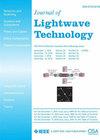Coupled-Core Transmission at 100-Gbaud with Low-Complexity, Fast-Tracking 4D × D MIMO Equalizer
IF 4.1
1区 工程技术
Q2 ENGINEERING, ELECTRICAL & ELECTRONIC
引用次数: 0
Abstract
Space division multiplexing (SDM) has emerged as a pivotal technology for scaling the capacity of future high-capacity optical transmission systems. Large-scale multiple-input/multiple-output (MIMO) digital signal processing-based SDM systems that utilize media with inherent strong crosstalk between spatial channels, such as coupled-core multicore fibers, are particularly promising for achieving unprecedented transmission capacities. To alleviate the inherent complexity of these massively parallel systems, an SDM-MIMO signal processing scheme needs to be developed that can efficiently handle high-symbol-rate transmissions. In this context, we present a partially frozen (PF) 4D×D multiple-input/multiple-output adaptive equalizer (MIMO AEQ), tailored specifically for robust high-symbol-rate SDM-MIMO signal reception. This approach is designed to combat electrical IQ impairments—a predominant obstacle in high-symbol-rate transmission—while simultaneously enhancing tracking ability to channel dynamics and reducing computational complexity. We detail the operational principles of the PF 4D×D MIMO AEQ and validate its performance through simulations and experiments. Our results underscore its validity, demonstrating a net transmission of 2.6 (0.65×4) Tb/s/λ over a dynamically fluctuating four-coupled-core cabled transmission line using 100-Gbaud 16QAM signals.求助全文
约1分钟内获得全文
求助全文
来源期刊

Journal of Lightwave Technology
工程技术-工程:电子与电气
CiteScore
9.40
自引率
14.90%
发文量
936
审稿时长
3.9 months
期刊介绍:
The Journal of Lightwave Technology is comprised of original contributions, both regular papers and letters, covering work in all aspects of optical guided-wave science, technology, and engineering. Manuscripts are solicited which report original theoretical and/or experimental results which advance the technological base of guided-wave technology. Tutorial and review papers are by invitation only. Topics of interest include the following: fiber and cable technologies, active and passive guided-wave componentry (light sources, detectors, repeaters, switches, fiber sensors, etc.); integrated optics and optoelectronics; and systems, subsystems, new applications and unique field trials. System oriented manuscripts should be concerned with systems which perform a function not previously available, out-perform previously established systems, or represent enhancements in the state of the art in general.
 求助内容:
求助内容: 应助结果提醒方式:
应助结果提醒方式:


